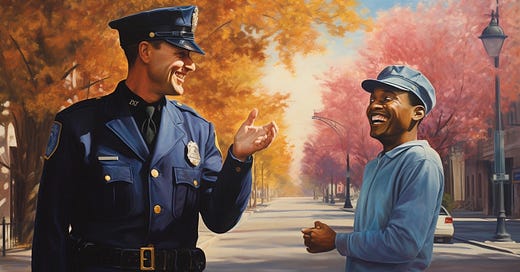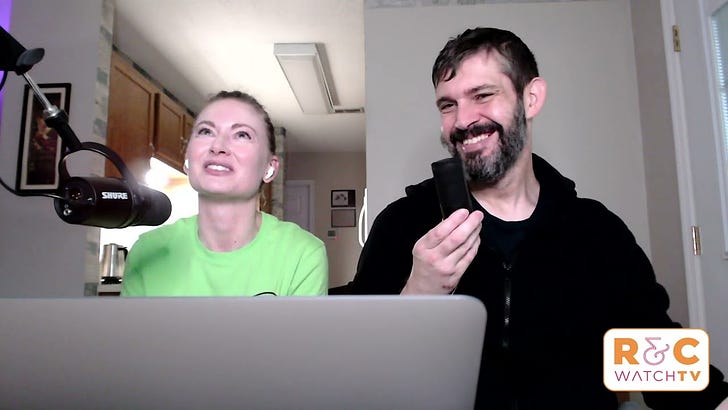Welcome, my dear sweet babies, to the fourth installment of the ACAB case for weaksauce police reform series. In part one we discussed why we need to professionalize policing. Part two was all about hiring more officers. Part three was a diatribe against proactive policing. Today’s post is all about what cops should do instead of proactive policing.
As established in our last post, proactive policing creates more crime in part by severing trust between police and the public.
Community policing is all about uniting the two.
Much of this post is adapted from a useful overview of community policing I found through The Office of Community Oriented Policing Services (COPS Office).
The goal of community policing is to find ways for the public to effectively collaborate with police departments toward the shared goal of enhancing public safety and improving overall quality of life. Here, the public is defined as stakeholder groups which might include private businesses, media outlets, non-profits, and other government agencies.
A 2019 Police Executive Research Forum study suggests this kind of collaboration can effectively address declining trust in police and help encourage more people to become cops.
The COPS Office community policing framework includes five key steps:
1. Update policing metrics
This is one of the most important changes police departments can make toward improving outcomes. What gets measured gets managed. How we evaluate cops for pay, promotions, and other incentives will impact how cops spend their time. Right now, departments evaluate police performance using metrics like how many arrests they make or tickets they write. The city of Ferguson, Missouri, for example, was using extremely heavy handed traffic enforcement in low-income, heavily Black neighborhoods as a significant source of revenue. This type of incentive structure leads to cops spending their time on activities that demonstrably create more crime overall. Not only that, but these kinds of searches, tickets, arrests, and convictions also ruin lives and sow distrust between cops and communities. They also exacerbate a host of social ills, including racial disparities in income and employment and fatherlessness.
Community policing essentially gives relevant stakeholders the opportunity to share which outcomes they would like to see from police departments.
These metrics might include community satisfaction, fear of crime, and quality of life measures. A department might survey the community yearly on these metrics and then evaluate how different initiatives impact each.
“Leaders need data on public attitudes to monitor the health of the relationship between police and the public—on a timeline that is rapid enough that the data can be used in decisionmaking,” writes Brian A. Jackson of the RAND Corporation.
Then departments should review, reward, and promote individual officers based on how well they’re doing the things that actually move the needle.
We know, for example, that clearing more major crimes has a bigger impact on overall crime than just making more arrests. So I’d imagine departments that reward cops based on their major crimes clearance rate will see a bigger reduction in fear of crime than departments who just measure each cop’s number of total arrests.
2. Increase transparency
For community policing to really work, communication between police and the public has to be a two-way street. Cops must readily share relevant information on crime and police operations with the communities they serve. Don’t you worry, I’ll expand on this idea in my next post.
3. Build relationships
Community policing is all about re-building the broken trust between cops and communities. The problem is, it’s very hard to trust someone you don’t know. This is especially true when that person wears a uniform you correctly associate with abuse.
Each cop is an individual. Some are better than others. And some are better suited to certain beats and neighborhoods than others. But no matter what, it’s faster and easier for four or six cops to build trust with one neighborhood than it is for a whole department to build trust with an entire city. And it’s simply impossible for every cop in a department to truly get to know and understand every block of their entire city.
Departments should consider neighborhood boundaries when creating beats. And they should allow officers to work those beats for months and years at a time. Without this focus and time, it’s much harder for cops to form and maintain healthy, informed, cooperative relationships with the people they serve. And it should make cops’ jobs that much easier, since most people are a lot more cooperative with people they know and trust.
This, along with precision policing, can re-build trust while making the job of policing a lot easier.
4. Improve recruitment
There are a lot of good reasons to want to be a cop. The best police are willing to put themselves in harm’s way to keep people safe and maintain the rule of law. These are people with a “spirit of service.”
There are also a lot of bad reasons to want to be a cop. The worst police want to operate outside the law and want the power to bully, beat up, or even kill without consequence. It’s one of the few jobs where a low-IQ, low-skill, high-school graduate can get a paycheck, a car, a gun, and a get-out-of-jail free card within a few months of applying. These are people the COPS framework euphemistically describe as having a “spirit of adventure.”
Departments should be looking for the former when hiring and avoiding the latter at all costs.
5. Encourage participation
Just as departments need to be communicating out to the public, they also need to solicit community input on metrics, beat assignments, recruitment efforts, and more.
Departments should host regular meetings with community groups. They should encourage stakeholders to convene review boards. And they should identify representatives of community groups and proactively invite them to meet and discuss relevant issues on an ongoing basis.
People will actually show up and participate once they realize departments are willing and able to implement at least some of their input. The beauty of agreeing on overall metrics like quality of life measures means that a department can implement a suggested change for six months or a year, measure its impact on the relevant metrics, and then decide whether to keep it.
Going forward
This is one of those proposals where I have to stop to ask myself, how is this not the default already? Like, why aren’t all police departments measuring the outcomes that actually matter and then evaluating cops based on how well they’re doing the things that lead to good outcomes? And the answers, in sum, are one, police departments are government agencies and government agencies don’t actually have to do anything useful to continue to exist and the people who work for them are actually often incentivized to exacerbate the problems they’re nominally supposed to be solving. And two, well, it rhymes with soleece schunions.
But, all is not lost. With enough public pressure, police departments can and do change how they do business. And changing to a community policing model can help create a virtuous cycle of public input, police accountability, and better outcomes.
Sex and the State is a newsletter at the intersection of policy and people. Like it? Upgrade to a paid subscription, buy a guide, follow me on Twitter, support me on Patreon, or just share this post 🙏
~~~~~
This ⬇️ is an affiliate link! Sign up today to support me!
Join the reading revolution! Get key ideas from bestselling non-fiction books, distilled by experts into bitesize text and audio. Explore our vast library of over 5,500 titles and stay up-to-date with 40 new titles added each month.
















Share this post